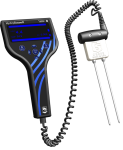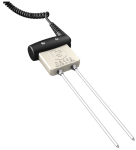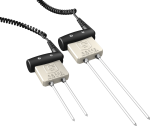
電気伝導率の高い土壌でより正確






利点と特徴
- 土壌固有のキャリブレーションを行うことなく、バルクECが3 dS m-1までの土壌でより正確な含水量測定が可能
- サンプル量が多いため誤差が少ない
- 土質と電気伝導率の影響を補正して測定
- 幅広い鉱物性土壌の土壌水分量を推定
- 誘電率、バルク電気伝導率(EC)、土壌温度を測定する多用途センサ
イメージ




詳細
仕様
| 測定項目 | 土壌電気伝導率 (EC)、比誘電率、体積水分含有量 (VWC)、土壌温度 |
| 必要なシステム | 測定システム |
| 土壌適合性 | 感知容積が大きい (> 6 L) 長いロッドは、低から中程度の電気伝導率の土壌に適しています。 |
| ロッド | 交換不可 |
| センサ | 互換性なし |
| 感知範囲 | 7800 cm3 (各プローブ ロッドの周囲半径約 7.5 cm、ロッドの端から 4.5 cm) |
| 電磁 |
CE 準拠 静電気放電およびサージに対する保護に関する EN61326 要件を満たしています。 |
| 動作温度範囲 | -50° ~ +70°C |
| センサ出力 | SDI-12、シリアル RS-232 |
| ウォームアップ時間 | 3 秒 |
| 測定時間 | 測定に 3 ミリ秒、SDI-12 コマンドの完了に 600 ミリ秒 |
| 電源要件 | 6 ~ 18 Vdc (12 Vdc で 45 mA を供給できる必要があります。) |
| 最大ケーブル長 | 610 m (2000 フィート) 同じデータロガーのCポートに接続された最大 25 個のセンサの合計長さ |
| ロッド間隔 | 32 mm (1.3 in.) |
| 侵入保護等級 | IP68 |
| ロッド直径 | 3.2 mm (0.13 in.) |
| ロッド長さ | 300 mm (11.8 in.) |
| プローブヘッド寸法 | 85 x 63 x 18 mm (3.3 x 2.5 x 0.7 in.) |
| ケーブル重量 | 35 g / メートル (0.38 oz / ft) |
| プローブ重量 | 280 g (9.9 oz) ケーブル除く |
消費電流 |
|
| アクティブ (3 ms) |
|
| 静止 | 135 µA (通常) (@ 12 Vdc) |
EC |
|
| 溶液 EC の範囲 | 0 ~ 3 dS/m |
| バルク EC の範囲 | 0 ~ 3 dS/m |
| 正確度 | ±(読み取り値の5% + 0.05 dS/m) |
| 精密度 | BECの0.5% |
比誘電率 |
|
| 範囲 | 1 ~ 81 |
| 正確度 |
|
| 精密度 | < 0.02 |
体積含水率 |
|
| 範囲 | 0 ~ 100% (M4 コマンド使用時) |
| 水分含有量の正確度 |
|
| 精密度 | < 0.05% |
地温 |
|
| 範囲 | -50° ~ +70°C |
| 分解能 | 0.001°C |
| 正確度 |
|
| 精密度 | ±0.02°C |
互換性
注意: 以下は代表的な互換性情報を示しています。互換性のある製品や互換性のない製品をすべて網羅したリストではありません。
Data Loggers
| 製品 | 互換性 | 注意 |
|---|---|---|
| CR1000 (リタイア) | ||
| CR1000X (リタイア) | ||
| CR300 (リタイア) | ||
| CR3000 (リタイア) | ||
| CR310 | ||
| CR350 | ||
| CR6 | ||
| CR800 (リタイア) | ||
| CR850 (リタイア) |
互換性に関する追加情報
RF(無線周波数)に関する考慮すべき事柄
外部RFソース
外部 RF ソースはプローブの動作に影響を与える可能性があります。したがって、プローブは、AC 電源ラインやモータなどの重要な RF ソースから離れた場所に設置する必要があります。
プローブ間の干渉
標準データロガー SDI-12 「M」 コマンドを使用する場合、複数の CS655 プローブを 4インチ以内に設置できます。SDI-12「M」コマンドでは、一度に有効にできるプローブは1つだけです。
オプションの取り付けツール
CS650Gを使用すると、密度が高い土壌や岩の多い土壌でも土壌水センサを簡単に挿入できます。CS650Gを使用しない場合、強い力を加えてセンサを挿入すると損傷する可能性があります。センサのロッドを挿入するための下穴を開けることができます。
ドキュメント
テクニカルペーパー
ダウンロード
CS650 / CS655 Firmware v.2 (429 KB) 02-12-2015
Current CS650 and CS655 firmware.
Note: The Device Configuration Utility and A200 Sensor-to-PC Interface are required to upload the included firmware to the sensor.
よくある質問
CS650に関するよくある質問の数: 54
すべて展開すべて折りたたむ
-
Campbell Scientific では、センサのロッドを短くすることは強くお勧めしません。センサ ヘッドの電子機器は、30 cm のロッドで動作するように最適化されています。これらのロッドを短くすると、周期平均が変わります。その結果、ファームウェアの方程式が無効になり、不正確な読み取り値が表示されます。
-
体積水分含有量の読み取り値は、センサのロッドの長さ全体にわたる平均水分含有量です。
-
バルク電気伝導率 (EC) 測定はセンサロッドに沿って行われ、ロッドが配置されている深さに関係なく、その距離にわたる EC の平均読み取り値となります。
-
いいえ。これらのセンサが機能する原理は、液体の水の誘電率が 80 近くあるのに対し、土壌の固体粒子の誘電率は約 3 ~ 6 であるということです。ガソリンやその他の炭化水素の誘電率は土壌粒子と同じ範囲にあるため、CS650 および CS655 では基本的に検出されません。
-
報告される体積水分含有量の測定値はロッドの全長に沿った平均値であるため、センサは土壌に完全に挿入する必要があります。そうしないと、測定値は空気と土壌の両方の平均となり、水分含有量が過小評価されることになります。センサ ロッドが長すぎて土壌に完全に入らない場合は、ロッドが土壌に完全に覆われるまで斜めに挿入することを推奨しています。
-
室温での水の誘電率は 80 に近くなります。CS650 と CS655 の両方のファームウェアは、誘電率の測定値が 42 を超えると体積水分含有量を NAN または 9999999 に変更するようにプログラムされています。水中でテストする場合は、水分含有量の測定値ではなく誘電率の測定値を確認してください。機能性のテストを行う場合は、センサを水から半分ほど引き出して、誘電率と体積水分含有量の測定値の両方を確認します。
-
CS650 シリーズ センサのファームウェアには、センサが誤りであると判明している数値を報告しないようにするための論理テストがいくつか組み込まれています。誤った読み取り値は、センサの動作限界外か、公表されている精度仕様外のいずれかです。
報告された値が NAN または 9999999 であっても、必ずしもセンサ ハードウェアに問題があることを意味するわけではありません。以下に概説する条件により、誘電率と体積水分含有量の値が NAN または 9999999 になる可能性があります。
SDI-12 通信の問題
次のすべてが当てはまる場合、センサとデータ ロガー間の SDI-12 通信に問題がある可能性があります。センサは M1! SDI-12 コマンドでポーリングされており、報告された誘電率の値は NAN であり、後続の値はすべてゼロであるか、まったく変化しません。考えられる原因は次のとおりです。
- センサに電源が入っていません。赤い線が 12 Vdc 電源に正しく接続され、黒い線がデータロガーのアースに接続されていることを確認してください。
- センサの信号線が正しく接続されていません。緑の線がデータロガー プログラムで指定された制御ポートに正しく接続されていることを確認してください。
- センサの SDI-12 アドレスがデータロガー プログラムと一致していません。
- センサにケーブルまたは落雷による損傷があります。
計算された誘電率が0未満または88より大きい
周期平均値と電気伝導率の値を誘電率に変換するために使用される式は、2 つの独立変数と 11 個の係数、およびオフセットを持つ 3 次元表面です。周期と電気伝導率のまれな組み合わせによっては、誘電率の計算結果が空気 (1) より低くなるか、0°C の水 (88) より高くなることがあります。これらのまれな組み合わせは、センサが土壌内にある場合には想定されません。
バルク電気伝導率(EC)は1.14 dS/m以上
バルク電気伝導率が 1.14 dS/m を超える場合、溶液 EC は 3 dS/m を超えます。これは、CS650 で正確に測定できる上限です。この状態になると、土壌は範囲外とみなされ、誘電率と体積水分含有量の両方に対して NAN または 9999999 の値が報告されます。
計算された誘電率は誘電率限界の80%未満
バルク電気伝導率 (EC) の測定値に基づく誘電率の限界は、飽和時のバルク EC がセンサの動作限界を超えているかどうかを判断するために使用されます。その誘電率の限界が計算され、誘電率の測定値と比較されます。測定された誘電率が誘電率の限界を 20% 以上超える場合、誘電率と体積水分含有量の両方が NAN または 9999999 として報告されます。これは、CS650 シリーズ センサで NAN 値が発生する最も一般的な原因であり、センサの故障ではなく土壌の特性によって発生します。
-
CS650 のロッドの長さは 30 cm、CS655 のロッドの長さは 12 cm です。ロッドの長さの違いにより、仕様に若干の変更が生じます。たとえば、誘電率と水分含有量の測定精度は CS650 の方がわずかに優れていますが、電気伝導率の範囲は CS655 の方が広くなっています。さらに、CS650 は測定体積が大きく、EC (電気伝導率) の低い砂や砂質ロームでも優れた精度を発揮します。CS655 は一般に土壌の精度が高く、広範囲の土壌テクスチャと EC で良好に機能し、ロッドが短いため設置も簡単です。
-
細粒分がかなり含まれる土壌 (ローム、シルトローム、シルト質粘土ローム、粘土ローム、粘土) では、これらの土壌は導電性が高くなる傾向があり、CS655 は CS650 よりも広い範囲の導電率で動作するため、CS655 が適切な選択肢となります。大型の温室ポットなど、測定体積を小さくしたい用途では、CS650 の 30 cm のロッドよりも、CS655 の 12 cm のロッドの方が適しています。
-
サーミスタは、ステンレス ロッドの 1 つに隣接するセンサのエポキシ ヘッドに収納されています。これにより、センサ ヘッドのその部分が土壌と接触する深さでの温度の正確なポイント測定が可能になります。このため、CS650 または CS655 の推奨方向は水平配置です。温度測定は、センサ ロッドの長さ全体で平均化されるわけではありません。
ケーススタディ
エバーグレーズ国立公園は、米国最大の熱帯自然保護区で、南フロリダの湿地帯の脆弱な生態系を保護するために設立されました。この公園は、世界遺産、生物圏保護区、国際的に重要な湿地帯として同時に登録されている世界 3 か所のうちの 1 つです。エバーグレーズはビスケーン帯水層の涵養地帯の上にあり、南フロリダの淡水供給の大部分の源となっています。 1920 年代にフロリダ州マイアミの西に米国ハイウェイ 41 (「タミアミ トレイル」) が建設される前は、淡水はフロリダ州を南に自由に流れ、エバーグレーズの湿地帯に水を供給していました。タミアミ トレイルは実質的に水の流れを遮断し、水はマイアミやその他の近隣の都市に転用され、農業や住宅用に沼地を排水する計画が立てられました。公園内の淡水の水位が下がると、塩水が侵入し、エバーグレーズの生態系が損なわれ、公園内の生物多様性に悪影響を及ぼします。公園の生態系の保護に費やされた 1 ドルごとに 4 ドルの利益がもたらされると推定されています。 消滅しつつあるエバーグレーズを守るため、1930......続きを読む
アグリボルタイクスまたはデュアルユースソーラーは、農作物(ブドウ栽培、樹木栽培、畑作物、または市場向け園芸)と太陽光発電パネルを同じ表面積に組み合わせたシステムであり、高い位置に配置され、植物の生理学的ニーズに応じて制御されます。この革新的な技術は、植物上の気候を変更してクリーンで再生可能で低コストの電力を生産することで、農業生産を向上させることを目的としています。Sun'R社が運営するSun'Agriプログラムの一環として、IRSTEA(UMR G-eau、モンペリエ)は、水の消費量を減らし、農業における水の使用効率を高めることを目的として、可変傾斜の太陽光発電パネルによって作物に作られる日陰の重要性を研究しています。最終的に、この研究は、太陽光発電パネルの傾斜による日陰管理を最適化するために、作物の発育と水収支モデルを適応および供給するのに役立ちます。この最適化により、農業の収穫量(量および/または品質)が向上し、再生可能エネルギーの開発が促進され、水資源を節約しながら土地利用の効率が最大化されるはずです。 この目標を達成するために、ADEME が資金を提供する Sun'Agri 3 投資プログラムの一環として、南フランスの畑作物、ブドウ、野菜、リンゴの木に 4 つの農業用発電装置が建設済みまたは建設予定です。これらの装置には、次の機能を実現する Campbell Scientific の機器が装備されています。 SP1110 放射センサー、CS215 温湿度計、ARG100 雨量計、風速計を使用した日陰が微気候と蒸発散に与える影響の評価......続きを読む
記事とプレスリリース
Privacy Policy Update
We've updated our privacy policy. 詳細はこちら
Cookie Consent
Update your cookie preferences. クッキーの設定を更新する











